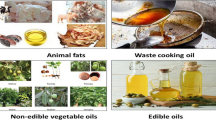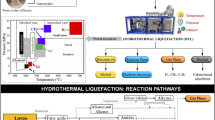Abstract
Production of structured triacylglycerols (sTAG) containing eicosapentaenoic acid (EPA) at the sn-1 (or 3) position using Lipozyme in a solvent-free system was studied. Optimal water activity (a w) for the synthesis of the sTAG was investigated. Vacuum was applied to shift reaction equilibrium toward the synthesis reaction by removing by-products. During vacuum application, the water level of the reaction system was controlled at the optimal level by addition of a suitable amount of water at a predetermined interval. Intermittent periodic addition of a suitable amount of water into the reaction mixture made the reaction rate faster than that without adding water. A molar yield of 89.7% of the targeted sTAG was obtained after 16 h reaction with a w control during the vacuum application as compared with the yield of 87.0% after 24 h of reaction without a w control during the vacuum application.
Similar content being viewed by others
Abbreviations
- C8EE:
-
caprylic acid ethylester
- DHA:
-
docosahexaenoic acid
- EPA:
-
elcosapentaenoic acid
- EPA-C8-C8:
-
1-eicosapentaenoyl-2,3-dicaprylin and/or 1,2-dicapryl-3-eicosapentaenoin
- EPAEE:
-
EPA ethyl ester
- MCFA:
-
medium-chain fatty acids
- PUFA:
-
polyunsaturated fatty acids
- sTAG:
-
structured triacylglycerols
- TAG:
-
triacylglycerols
References
Gill, I., and Valivety, R. (1997) Polyunsaturated Fatty Acids, Part 1: Occurrence, Biological Activities and Applications, TIBTECH 15, 401–408.
Jandacek, R.J., Whiteside, J.A., Holcombe, B.N., Volpenhein, R.A., and Taulbee, J.D. (1987) The Rapid Hydrolysis and Efficient Absorption of Triacylglycerols with Octanoic Acid in the 1 and 3 Positions and Long Chain Fatty Acid in the 2 Position, Am. J. Clin. Nutr. 45, 940–945.
Akoh, C.C. (1995) Structured Lipids—Enzymatic Approach, INFORM 6, 1055–1061.
Lee, K.T., and Akoh, C.C. (1996) Immobilized Lipase-Catalyzed Production of Structured Lipids with Eicosapentaenoic Acid at Specific Positions, J. Am. Oil Chem. Soc. 73, 611–615.
Soumanou, M.M., Bornscheuer, U.T., Menge, U., and Schmid, R.D. (1997) Synthesis of Structured Triglycerides from Peanut Oil with Immobilized Lipase, J. Am. Oil Chem. Soc. 74, 427–433.
Hamosh, M., and Hamosh, P. (1996) Specificity of Lipases: Developmental Physiology Aspects—The Role of Lipase Selectivity in the Digestion of Milk Fat, in Enzyme Engineering of/with Lipases (Malcata, F.X., ed.) pp. 31–49, Kluwer Academic Publishers, Dordrecht.
Iverson, S.J., Kirk, C.L., Harmosh, M., and Newsome, J. (1991) Milk Lipid Digestion in the Neonatal Dog: The Combined Actions of Gastric and Bile Salt Stimulated Lipases, Biochim. Biophys. Acta 1083, 109–119.
Christensen, M.S., Høy, C.-E., Becker, C.C., and Redgrave, T.G. (1995) Intestinal Absorption and Lymphatic Transport of Eicosapentaenoic (EPA), Docosahexaenoic (DHA), and Decanoic Acids: Dependence on Intramolecular Triacylglycerol Structure, Am. J. Clin. Nutr. 61, 56–61.
Innis, S.M. (1992) n−3 Fatty Acid Requirements of the Newborn, Lipids 27, 879–885.
Iverson, S., Sampugna, J.J., and Oftedal, O.T. (1992) Positional Specificity of Gastric Hydrolysis of Long Chain n−3 Polyunsaturated Fatty Acids of Seal Milk Triglycerides, Lipids 27, 870–878.
Tanaka, Y., Fukuda, T., Hirano, J., and Hashizume, R. (1993) Triglyceride Specificity of Candida cylindracea Lipase: Effect of Docosahexaenoic Acid on Resistance of Triglyceride to Lipase. J. Am. Oil Chem. Soc. 70, 1031–1034.
Han, J.J., Iwasaki, Y., and Yamane, T. (1999) Monitoring of Lipase-Catalyzed Transesterification Between Eicosapentaenoic Acid Ethyl Ester and Tricaprylin by Silver Ion High-Performance Liquid Chromatography and High-Temperature Gas Chromatography, J. Am. Oil Chem. Soc. 76, 31–39.
Han, J.J., Iwasaki, Y., and Yamane, T. (1999) Use of Isopropanol as a Modifier in a Hexane-Acetonitrile Based Mobile Phase for the Separation of Positional Isomers of Triacylglycerols Containing Long Chain Polyunsaturated Fatty Acids in Silver Ion HPLC Method, J. High Resolut. Chromatogr. 22, 357–361.
Yamane, T. (1988) Importance of Moisture Content Control for Enzymatic Reactions in Organic Solvents: A Novel Concept of “Microaqueous”, Biocatalysis 2, 1–9.
Zaks, A., and Klibanov, A. (1988) The Effect of Water on Enzyme Action in Organic Media, J. Biol. Chem. 263, 8017–8021.
Goldberg, M., Thomas, D., Legoy, M.D. (1990) Water Activity as a Key Parameter of Synthesis Reactions: The Example of Lipase in Biphasic (liquid/solid) Media, Enzyme Microb. Technol 12, 976–981.
Han, J.J., and Rhee, J.S. (1998) Effect of Salt Hydrate Pairs for Water Activity Control on Lipase-Catalyzed Synthesis of Lysophospholipids in a Solvent Free System, Enzyme Microb. Technol. 22, 158–164.
Kwon, S.J., and Rhee, J.S. (1998) On-Off Dewatering Control for Lipase-Catalyzed Synthesis of n-Butyl Oleate in n-Hexane by Tubular Type Pervaporation System, J. Microbiol. Biotechnol. 8, 165–170.
Mensah, P., Gainer, J.L., and Carta, G. (1998) Adsorptive Control of Water in Esterification with Immobilized Enzymes: I. Batch Reactor Behavior. Biotechnol. Bioeng. 60, 434–444.
Clapes, P., Valencia, G., and Adlercreutz, P. (1992) Influence of Solvent and Water Activity on Kinetically Controlled Peptide Synthesis, Enzyme Microb. Technol. 14, 575–580.
Kvittinggen, L., Sjursnes, B., Anthonsen, T., and Halling, P.J. (1992) Use of Salt Hydrates to Buffer Optimal Water Level During Lipase-Catalyzed Synthesis in Organic Media: A Practical Procedure for Organic Chemists, Tetrahedron 48, 2793–2802.
Halling, P.J. (1994) Thermodynamic Predictions for Biocatalysis in Nonconventional Media: Theory, Tests, and Recommendations for Experimental Design and Analysis, Enzyme Microb. Technol. 16, 178–206.
Valivety, R.H., Halling, P.J., and Macrae, A.R. (1992) Reaction Rate with Suspended Lipase Catalyst Shows Similar Dependence on Water Activity in Different Organic Solvents, Biochim. Biophys. Acta 1118, 218–222.
Author information
Authors and Affiliations
Corresponding author
About this article
Cite this article
Han, J.J., Yamane, T. Enhancement of both reaction yield and rate of synthesis of structured triacylglycerol containing eicosapentaenoic acid under vacuum with water activity control. Lipids 34, 989–995 (1999). https://doi.org/10.1007/s11745-999-0449-6
Received:
Revised:
Accepted:
Issue Date:
DOI: https://doi.org/10.1007/s11745-999-0449-6




